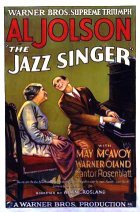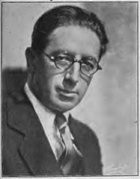
The Jazz Singer Page #4
- UNRATED
- Year:
- 1927
- 88 min
- 1,245 Views
37.INT. MULLER'S CAFE
Long shot discloses one of those places so common in New York before
Prohibition, a long bar in front, and behind, separated from the bar by
a partition and swinging doors, a "garden" approachable from the "family
entrance" where "ladies" may dine and drink their beer, whether with
escorts or without them. The back of the place can be seen faintly. The
bar is being well patronized, and the three German bartenders are busy
putting out huge schooners of the amber fluid. Waiters are going in and
out of the swinging doors.
Looking toward the bar, there is a battered old piano in the foreground
on a slightly raised platform, at which sits a young man who looks twice
his age because of dissipation. He is smoking a cigarette in a listless
manner, and there is a schooner of beer on the piano at the end of the
keyboard. He is running his hands over the keys as though playing to
himself. Back of him may be seen the diners and drinkers. There is an
occasional family group and several of the tables are occupied by
flashily dressed women of an obviously well-known occupation. Some are
accompanied by men. At other tables are men alone quietly drinking.
39.CLOSE-UP FAMILY ENTRANCE
Seen from the inside, the door opens slowly and the head of Jakie
Rabinowitz appears. He looks about as though to see if the coast is
clear, then enters. His attitude indicates that he has been there
before.
40.FULL SHOT GARDEN
Jakie threads his way among the tables to the piano. Several of the
drinkers look at him as they recognize the boy, and there is some
conversation about him among the groups. Jakie calls to the piano
player, who swings around to greet him, as he gets on the platform.
41.CLOSE SHOT FLAYER AND JAKIE
The pianist greets Jakie jocularly:
TITLE 11:
"Well how's the kid Caruso today?"Jakie answers him in kind:
TITLE 12:
"Great! How's old kid Paderooski?"They laugh and the piano player indicates the diners and drinkers,
saying that maybe there's a few dimes for the kid in the place. They
confer a moment, then the piano player whirls around and strikes a
chord.
42.FULL SHOT GARDEN
Those at the tables look toward the piano with interest as Jakie, in the
background, is seen standing on the little platform facing them.
43.MED. SHOT BOY AND PIANO PLAYER
The player plays the introduction to "Mighty Lak a Rose" and the boy
starts to sing. (The various shots for this will have to be in
accordance with Vitaphone technique and its necessities.) Vitaphone
singing stops, when cut is made.
Translation
Translate and read this script in other languages:
Select another language:
- - Select -
- 简体中文 (Chinese - Simplified)
- 繁體中文 (Chinese - Traditional)
- Español (Spanish)
- Esperanto (Esperanto)
- 日本語 (Japanese)
- Português (Portuguese)
- Deutsch (German)
- العربية (Arabic)
- Français (French)
- Русский (Russian)
- ಕನ್ನಡ (Kannada)
- 한국어 (Korean)
- עברית (Hebrew)
- Gaeilge (Irish)
- Українська (Ukrainian)
- اردو (Urdu)
- Magyar (Hungarian)
- मानक हिन्दी (Hindi)
- Indonesia (Indonesian)
- Italiano (Italian)
- தமிழ் (Tamil)
- Türkçe (Turkish)
- తెలుగు (Telugu)
- ภาษาไทย (Thai)
- Tiếng Việt (Vietnamese)
- Čeština (Czech)
- Polski (Polish)
- Bahasa Indonesia (Indonesian)
- Românește (Romanian)
- Nederlands (Dutch)
- Ελληνικά (Greek)
- Latinum (Latin)
- Svenska (Swedish)
- Dansk (Danish)
- Suomi (Finnish)
- فارسی (Persian)
- ייִדיש (Yiddish)
- հայերեն (Armenian)
- Norsk (Norwegian)
- English (English)
Citation
Use the citation below to add this screenplay to your bibliography:
Style:MLAChicagoAPA
"The Jazz Singer" Scripts.com. STANDS4 LLC, 2024. Web. 25 Apr. 2024. <https://www.scripts.com/script/the_jazz_singer_878>.



Discuss this script with the community:
Report Comment
We're doing our best to make sure our content is useful, accurate and safe.
If by any chance you spot an inappropriate comment while navigating through our website please use this form to let us know, and we'll take care of it shortly.
Attachment
You need to be logged in to favorite.
Log In